View Post [edit]
| Poster: | dead-head_Monte | Date: | Jan 25, 2011 10:47am |
| Forum: | GratefulDead | Subject: | Alembic history |

(updated) - by Susan Wickersham
In 1968 Ron Wickersham and Susan Frates met at Pacific Recording Studio where Ron was designing the first multi-track mixing console for use with the studio's new Ampex MM-1000 16-track recording machine. It was the second one in use. The Grateful Dead was recording "AOXOMOXOA". At this time the recording was a side interest for Ron, whose main gig was working at Ampex as a design engineer. Among the many projects to his credit was the prototype for the first low-speed video tape recorder. I was hired by the studio to do a painting to spark up the room.
The Broadcast Archive — Ampex TV Equipment Section
the Ampex ACR-25 was introduced in 1970
it was the first automatic robotic library system
for recording and playback of television commercials
ACR-25 had dual 2-inch tape transports that were loaded with 2-inch video cassettes
video shows operation with carosel and cassettes fed from storage bins in center
Ampex Digital Optics (ADO) demo video
Ampex one-inch Equipment Catalog
VPR-3 demo video
VPR-3 operation video
Ampex VPR-3
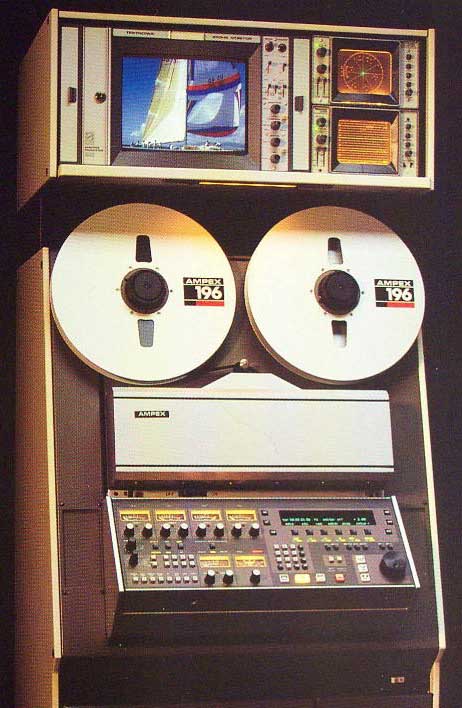
okay - now you know "who, where and how" Ron Wickersham cut his teeth - [back to Susan's history] In 1969 Ron left Ampex to devote all of his energies to the new field of multi-track recording. After working at Pacific Recording for 6 more months, he decided to leave Pacific Recording to form Alembic and work with The Grateful Dead who had a larger than average interest in improving the quality of their sound. Together they had plans for improving the quality of the final product, the record. We moved to Novato where the Dead had their office and rehearsal space in what was affectionately known as "The Pink behind Pinky's". The building was the color of Pepto-Bismol and was located down a long driveway behind Pinky's Pizza Parlor. We shared a fence with Hamilton Air Force Base. Alembic had its offices in the building with the Dead and separate workshop and living space behind the warehouse. The artist Bob Thomas lived there as well on the mezzanine. He was responsible for many of the Dead Album covers, such as "Live Dead" (painted on the mezzanine) and "Bear's Choice" (painted on the Alembic mezzanine three years later at 60 Brady St. in San Francisco). He also painted Alembic's logo. We all shared the kitchen and lounging areas. During 1969 we developed the Alembic electronics and pickups. We first installed them in David Crosby's 12-string Guild guitar (which he still uses to this day) and then into Phil Lesh's SG bass that had been hand painted by Bob Thomas in his trademark renaissance/psychedelic style. After several more experimental designs, both Phil Lesh's and Jack Casady's hollow-bodied Guild basses were renovated with new low-impedance pickups and new active electronics.
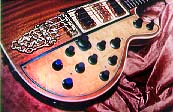
![]()
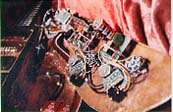
Bobby Weir's and Jerry Garcia's guitars were done as well. Slowly all aspects of the Dead's gear for the road and the studio were becoming "Alembicized!" During the late summer and fall Ron was invited to participate as an instructor, along with Fred Catero and David Rubinson in the Bill Graham Seminars. We met many interesting people who came to listen and learn from the talks. One of them was Rick Turner whom we later invited to work with us. Pacific Recording went out of the 16-track business almost as soon as it had entered it and Alembic acquired the MM-1000. We immediately turned to doing live recording as this we felt was the only way to truly capture the essence and electricity of the music as the audience and musicians fed upon the each other's energies and excitement. With Ron's improvements to the Dead's PA system and the new musical instruments, we were ready to pursue the project that consummated into the "Live Dead" album. This is still one of my all-time favorite Dead albums. The energy at those concerts was immense and magical. Alembic was also hired to provide the sound system and record the sound track for the Altamont concert that was filmed by the Maysles Brothers. It is the film known as "Gimme Shelter". The featured artists were The Rolling Stones, The Grateful Dead and The Jefferson Airplane. Yes, it was the concert that someone hired the Hell's Angels as stage security and to say they took their job a little too seriously would have to be an understatement. It was bad enough during the concert, but later that night when most of the crowds had left, the violence and destruction still went on. We lost part of our PA in a bonfire that someone had started. There was one unfortunate stoned individual that knocked over a bike and when it's owner tried to start it and it didn't respond, took out his anger on that individual with a little help from his gang. It was pretty brutal. 1969 was fast coming to an end with the usual all-niter Grateful Dead New Year's Eve Concert. They were joined by Crosby, Stills, Nash & Young, The Sons of Chaplain, The Ace of Cups, The Jefferson Airplane and solos by Joe Cocker. It was one of the best concerts I can remember. 1970 Alembic moved to 320 Judah Street, San Francisco in February. We were a small but potent company. There was Ron and myself as the owners and design team, then we hired John Curl, another engineer, Jim Furman, a former geometry teacher (later started Furman Sound Co.), as Ron's technician. "Kid" Candelario, "Sparkie" Mark Raizene and Steve Parrish were hired as roadies for the PA and recording equipment. These three later became part of the Grateful Dead road crew. There was a joke at the time that you had to do time at Alembic before you got on the Dead road crew. John Cutler, who currently does the mixing for the Dead, worked for and received much of his training from us. Frank Fuller was the head of our instrument repair section with Rick Turner working with him. We worked mainly on custom basses and refining the process of our electronics package. Through our instrument repair division combined with Ron's knowledge of physics, we worked on improving the structural integrity of instruments as well as the electronic and sustain characteristics of instruments. David Crosby's 12-string Guild guitar and Phil Lesh's Guild bass were among the first complete renovations we did. Phil's bass featured the first quadrophonic electronics. "Gee Ron, do I really need 20 knobs on my bass?" Ask anyone who heard Phil play it and you'll get an emphatic "yes!" Live recording and PA work was a large part of our company during this period. We recorded "Workingman's Dead", "ACE" (Bobby Weir), Garcia's "Wheel" and the New Riders of the Purple Sage to name a few. Alembic became a Corporation in the summer of 1970. Ron invited Bob Matthews and Rick Turner to participate in the company and gave them both equal stock to encourage them in this newest endeavor. In the summer of 1970 Alembic embarked on its largest venture to date. We did the PA and soundtrack for a movie that Warner Bros. was making called "Medicine Ball Caravan". The French documentary film-maker Francois Reinchenbeck was the director and Tom Wolfe was along and wrote the book of the same title. This must have seemed like old home week for Tom since his writing of "The Electric Kool-Aid Acid Test". Many of the same people featured in his book were on this "trip" as well. Some of the preparation for this trip included tie-dying huge canvas teepees, that we were going to be sleeping, showering, eating etc. in, to the outfitting of buses to carry the various crews for filming, recording, cooking, roadies and other interesting personalities. Wavy Gravy was there in a body cast, I remember it was difficult for him to shower. There were many others from the original Ken Keasey Merry Pranksters and Hog Farmers. All of the buses had names painted on them. Ours was "Pursuit". The slogan, "We have come for your daughters (and sons)", was prominently displayed on the front and back pf the bus. We would pull into our target town/city like Taos, New Mexico say and do a free live concert with BB King, then hit the road to Nebraska and do a campfire recording of Joni Mitchell. By the way, Nebraska didn't cotton to us being there and the day after our concert, the state troopers escorted us out of town. Our last USA concert was outdoors behind the National Archives in Washington, D.C. featuring Alice Cooper, what a crowd pleaser. After some time off for good behavior we then flew Air India from New York to London. Along with about 60 members of the troupe on the plane, we landed at Heathrow Airport. I can still see the odd look on the faces of the people waiting to get through customs when we came piling into the airport. It was one of mixed emotions of fear, amazement, amusement and of course disapproval. No matter, the last gig for the "Caravan" was Pink Floyd, all night at the University of Kent at Canterbury. This was the same week-end that Dylan did the Isle of Wight concert. It was a cold night in Canterbury with a great deal of fog that only added to the surrealism of the music and the mood that spread through the crowd with the intensity of an electric wire. It was unbelievable. 1971 Alembic moved to 60 Brady Street in San Francisco, taking over the former Pacific High Recording Studio. We did a lot of renovation. The facility was transformed into a state-of-the art sixteen track recording studio. We also established a music store in which we sold the new Alembic guitars and basses. All Series I/II come with our PF-5 electronics as well as Alembic cabinets, complete with tye-dyed speaker fronts.

We also sold McIntosh amps, JBL, EV, Gauss, Shure, B&K, custom cables etc. etc. We offered a PA design and consultation service that was headed by Ron Wickersham. Alembic had the largest physical studio in San Francisco, large enough to hold a symphony orchestra with room to spare. The walls were movable panels to change the size and acoustics of the room. We did a lot of recordings in that studio. Stephen Stills, The Grateful Dead, New Riders of the Purple Sage, Gordon Lightfoot, Johnny Winters, Santana, The Doobie Brothers and the Youngbloods to name just a few. We wanted the guests to be comfortable and entertained so we had a R & R area with the first ever video game brought in to compliment the pinball machines. Does anyone remember "Pong"? It was addicting to play video games even as simple as that one back then. The Alembic R & D department was busy, introducing the first parametric equalizer which Ron designed for Bobby Weir. We embarked on a new project for the Dead, one that later would have world-wide fame and acclaim. It would be dubbed, "The Wall of Sound", and it was. 1972 Preparations were being made for a big European Tour with the Dead. The album would be simply named, "Europe '72". Ron was entrenched in redesigning the Ampex MM-1000 from the existing transport that accommodated 10" reels as it was not adequate to capture as much of the live performance without interruption as possible. Since you could never plan on how long the Dead would play once they got started on a jamming session, a trademark of theirs to say the least, it was better to be prepared and plan ahead. After all, you might miss the most exotic combination of notes right when it was necessary to change the reels of tape, bummer city. Ron was additionally transforming the MM-1000 from its unwieldy flat transport with eight tracks on top and eight tracks below into a video transport that would accommodate the 14" reels as well as redesign it to 30ips to improve the sound quality and reduce the drop-out rate. The engineers at Ampex thought this was a pretty cool idea and dropped on by to take notes. We started writing a monthly column for Guitar Player Magazine called the ALEMBIC REPORT in which we critiqued products from other companies. During this high time, even with recording and PA development, we were not neglecting the need for superior instruments. We took all that we had learned and experimented with and completed the now famous Jack Casady bass that appeared in Guitar Player as "Jack's $4,000.00 Custom".
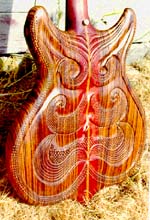 |
The bass was made of Zebrawood with lots of purpleheart wood that Rick carved over the entire back and some of the front. The fingerboard had a "Tree of Life" style of inlay. The pickups were movable, traveling on brass tubing installed in the front of the bass. The active electronics were later enhanced by the addition of a superfiltering system. Stanley Clarke got his first Alembic bass in 1972. This was the beginning of what was and continues to be a life long relationship with one of the quintessential bassist in the world. This was the year that Rolling Stone did a special insert on Pro Audio Gear in one of the issues. There was quite a spread, over two pages on Alembic alone. There's a group photo in the article that shows Mica as a two year old and Ron and I still have dark hair (and lots of it, too)! The article dealt with the high tech aspects of our entire company from recordings and sound system specialists to the custom instrument aspect of what we were trying to accomplish, which was to improve the quality of recorded music. It was also at this time that we took on another stockholder, a good friend Sam Field. continued at Alembic
the Wall of Sound doc
description by Ron Wickersham
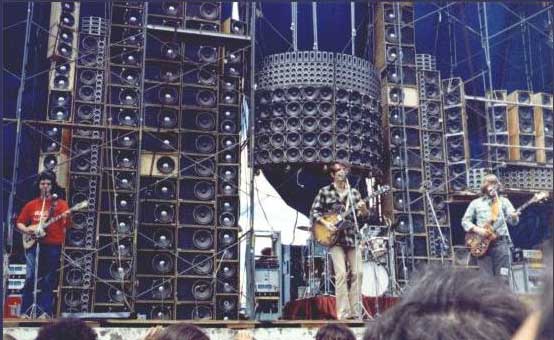
VPR-5 portable one-inch VTR co-developed by Ampex & Nagra in early 1984
this product earned an Emmy Award for Technical Excellence
take a look under the hood
VPR-5 wins Emmy Award
This post was modified by dead-head_Monte on 2011-01-25 18:47:38
Reply [edit]
| Poster: | deadpolitics | Date: | Jan 25, 2011 11:38am |
| Forum: | GratefulDead | Subject: | Re: Alembic history |
Reply [edit]
| Poster: | Earl B. Powell | Date: | Sep 17, 2009 7:02am |
| Forum: | GratefulDead | Subject: | Re: Alembic history |
Bear had an inventors lab at the band's practice area and offices and persuaded Wickersham to leave AMPEX and work solely on Grateful Dead projects. The day Wickersham showed up for work was the same day that Lenny Hart began managing the band. He fired Wickersham, so Bear, in fear of losing Ron, started a separate company which became Alembic.
Reply [edit]
| Poster: | William Tell | Date: | Jan 25, 2011 12:46pm |
| Forum: | GratefulDead | Subject: | Re: Alembic history |
Thought if I reply to this one, maybe, just maybe you'll get the notification?
If so, and you're "here", hope you're fine, and it wasn't anything Dire said that made you run for the high cold plains of purple sage (assume that's where you're hiding out!).
Reply [edit]
| Poster: | light into ashes | Date: | Jan 25, 2011 11:54pm |
| Forum: | GratefulDead | Subject: | Re: Alembic history |
Reply [edit]
| Poster: | William Tell | Date: | Jan 26, 2011 5:46am |
| Forum: | GratefulDead | Subject: | Re: Alembic history |
Reply [edit]
| Poster: | SkyDawg | Date: | Sep 15, 2009 10:59pm |
| Forum: | GratefulDead | Subject: | Re: Alembic history |
Like you, I was lucky enough to have seen and heard it in person in June of 1974. My main impression of the Wall of Sound was somehow tied into the movie "2001- A Space Odyssey" and it's opening scenes I remember thinking that at the Wall Of Sound show I saw (on 6/20/74), how this thing looked like the giant monolith that drove all those apes crazy at the beginning of that movie. It was so huge! You could start a whole new religion or something like that.. Maybe I WAS high that night, but that is my lasting memory of the show.
Alembic, and all of it's founders were true pioneers. Wizards of Sound.
Reply [edit]
| Poster: | barongsong | Date: | Sep 18, 2009 11:35am |
| Forum: | GratefulDead | Subject: | Re: Alembic history |
Reply [edit]
| Poster: | RBNW....new and improved! | Date: | Sep 16, 2009 12:58am |
| Forum: | GratefulDead | Subject: | Re: Alembic history |
Reply [edit]
| Poster: | RBNW....new and improved! | Date: | Sep 16, 2009 1:21am |
| Forum: | GratefulDead | Subject: | find the lady or 3 card! |
Reply [edit]
| Poster: | RBNW....new and improved! | Date: | Sep 18, 2009 7:47am |
| Forum: | GratefulDead | Subject: | Re: Alembic history |
Reply [edit]
| Poster: | RBNW....new and improved! | Date: | Sep 16, 2009 12:58am |
| Forum: | GratefulDead | Subject: | Re: Alembic history |
Reply [edit]
| Poster: | RBNW....new and improved! | Date: | Sep 16, 2009 11:03am |
| Forum: | GratefulDead | Subject: | Re: Alembic history |
As the mark watches the game, they are likely to notice that they can follow the queen more easily than the shills seem to be able to, which sets them up to believe that they can beat the game.
Eventually, if the mark enters the game, they will be cheated through any number of methods. An example of a simple scheme involves a dealer and two shills, as follows:
* The dealer and shills act as if they do not know each other. The mark will come upon a game being conducted in a seemingly clandestine manner, perhaps with somebody "looking out" for police. The dealer will be engaged in his role, with the first shill betting money. The first shill may be winning, leading the mark to observe that easy money may be had, or losing, leading the mark to observe that he could beat the game and win money where the first shill is losing it.
* While the mark is watching, the second shill, acting as if he is a casual passerby like the mark, will casually engage a mark in conversation regarding the game, commenting on either how easily the first shill is winning or how he is losing money because he cannot win at what appears to the mark to be a simple game. This conversation is engineered to implicitly encourage the mark to play, and it is possible the second shill could resort to outright encouragement.
* If the mark does not enter the game, the dealer may claim to see police and will fold up his operation and restart it elsewhere, or will wait for another mark to appear on the scene.
* If the mark enters the game, they may be "had" (cheated) by a number of techniques. A common belief is that the operator may let the mark win a couple of bets to suck them in, but this is virtually never true. In a true Monte scam, the mark is unlikely to ever win a single bet; it is simply not necessary. There are just too many ways for a well-run mob to attract the marks, suck them in, and convince them to put money down.
* When the dealer and the shills have taken the mark, a lookout, the dealer, or a shill acting as an observer will claim to have spotted the police. The dealer will quickly pack up the game and together with the shills will disperse.
Reply [edit]
| Poster: | jackstraw86 | Date: | Apr 8, 2009 4:54pm |
| Forum: | GratefulDead | Subject: | Re: Alembic history |
Reply [edit]
| Poster: | Dhamma1 | Date: | Apr 8, 2009 5:39pm |
| Forum: | GratefulDead | Subject: | Re: Alembic history |
Reply [edit]
| Poster: | RBNW....new and improved! | Date: | Sep 15, 2009 10:36pm |
| Forum: | GratefulDead | Subject: | Re: Alembic history |
Reply [edit]
| Poster: | RBNW....new and improved! | Date: | Sep 15, 2009 10:36pm |
| Forum: | GratefulDead | Subject: | Re: Alembic history |
Reply [edit]
| Poster: | dead-head_Monte | Date: | Sep 20, 2009 8:43am |
| Forum: | GratefulDead | Subject: | Re: Alembic history |
 |
Phil's Alembic bass and his rig
 |
Reply [edit]
| Poster: | dead-head_Monte | Date: | Oct 28, 2010 12:26pm |
| Forum: | GratefulDead | Subject: | Re: Alembic history |
Reply [edit]
| Poster: | dead-head_Monte | Date: | Sep 25, 2009 7:47am |
| Forum: | GratefulDead | Subject: | Re: Alembic history |
 |
Jack Cassidy and Alembic bass number 1
 |
Reply [edit]
| Poster: | William Tell | Date: | Sep 16, 2009 8:01am |
| Forum: | GratefulDead | Subject: | Re: Alembic history |
 Live Music Archive
Live Music Archive Librivox Free Audio
Librivox Free Audio Metropolitan Museum
Metropolitan Museum Cleveland Museum of Art
Cleveland Museum of Art Internet Arcade
Internet Arcade Console Living Room
Console Living Room Books to Borrow
Books to Borrow Open Library
Open Library TV News
TV News Understanding 9/11
Understanding 9/11
